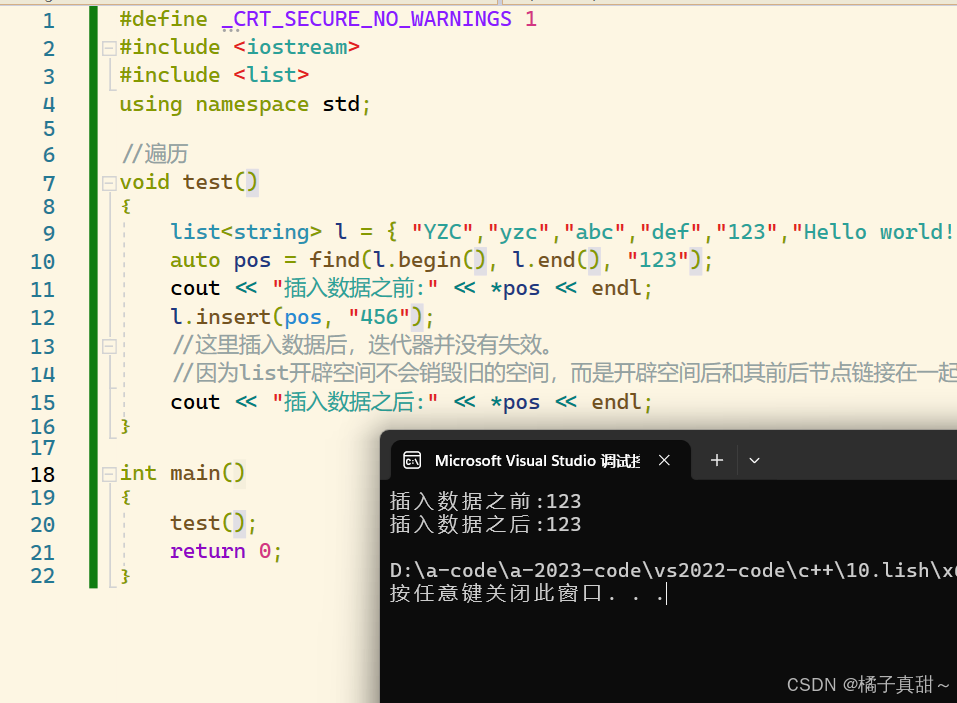⭐本篇重点:list的使用,list和vector的比较
⭐本篇代码:c++学习 · 橘子真甜/c++-learning-of-yzc - 码云 - 开源中国 (gitee.com)
目录
[一. list介绍](#一. list介绍)
[二. list的使用](#二. list的使用)
[2.1 构造函数](#2.1 构造函数)
[2.2 list的迭代器和遍历访问](#2.2 list的迭代器和遍历访问)
[2.3 list的增删查改](#2.3 list的增删查改)
[2.4 list迭代器失效的问题](#2.4 list迭代器失效的问题)
[三. vector和list的比较](#三. vector和list的比较)
一. list介绍
list文档:list文档
1 list是STL中的一个序列式容器,它在任意位置的插入和删除的时间复杂度都是O(1),并且可以支持双向迭代。
2 list的底层是一个双向链表,数据存储在节点中,每一个节点还存在指向前一个元素和指向后一个元素的指针。更准确的说,list是带头双向循环链表
3 list和forward_list非常相似,不过forword是单向链表,只能单方向迭代。
4 list和其他序列式容器(vector,queue)相比,优点是在任意位置插入和删除元素的时间复杂度都是O(1),list最大的缺点是不能够支持任意位置的随机访问,访问list中的元素时间复杂度为O(n)。
二. list的使用
2.1 构造函数
|-----------------------------------------------------------|--------------------------------|
| 构造函数 | 接口说明 |
| list() | 构造空的list |
| list (const list& x) | list的拷贝构造函数 |
| list (size_type n, const value_type& val = value_type()) | 构造的list中包含n个值为val的元素 |
| list (InputIterator first, InputIterator last) | 用迭代器[first, last)区间中的元素构造list |
2.2 list的迭代器和遍历访问
|----------|-------------------------------------|
| iterator | 解释 |
| begin() | 获取第一个数据位置 iterator/ const_iterator |
| end() | 获取最后一个数据位置 iterator/ const_iterator |
| rbegin() | 获取最后一个数据位置 reverse_iterator |
| rend() | 获取最后一个数据位置 reverse_iterator |
其中begin()和end()是正向迭代器,++迭代器向后移动
rbegin()和rend()是正向迭代器,++迭代器向前移动
list的迭代器的使用非常像指针
cpp
#define _CRT_SECURE_NO_WARNINGS 1
#include <iostream>
#include <list>
using namespace std;
//遍历
void test1()
{
list<int> l;
for (int i = 0; i < 10; i++)
l.push_back(rand());
//1.迭代器遍历
list<int>::iterator it = l.begin();
while (it != l.end())
{
cout << *it << " ";
++it;
}
cout << endl;
//2.迭代器逆向遍历
auto rit = l.rbegin();
while (rit != l.rend())
{
cout << *rit << " ";
++rit;
}
cout << endl;
//2. C++11 for循环
for (const auto& e : l)
cout << e << " ";
cout << endl;
}
int main()
{
test1();
}运行结果如下:

2.3 容量和获取元素接口
|---------|--------------|
| 容量接口 | 说明 |
| size() | 返回list中元素的个数 |
| empty() | 判断list是否为空 |
list可以获取第一个元素和最后一个元素
|---------|----------|
| 获取元素接口 | 说明 |
| front() | 获取第一个元素 |
| back() | 获取最后一个元素 |
测试代码:
cpp
#define _CRT_SECURE_NO_WARNINGS 1
#include <iostream>
#include <list>
using namespace std;
void test()
{
list<string> l = { "YZC","yzc","Hello world!"};
cout << l.size() << endl;
cout << l.empty() << endl;
cout << l.front() << endl; //YZC
cout << l.back() << endl; //Hello world!
}
int main()
{
test();
return 0;
}测试结果:

2.3 list的增删查改
|------------|-------------------|
| 函数接口的声明 | 解释 |
| push_back | 在list尾元素的后面插入一个数据 |
| push_front | 在list首元素的前面插入一个数据 |
| pop_back | 删除list的尾数据 |
| pop_front | 删除list的首数据 |
| insert | 在给定的pos位置插入数据val |
| erase | 删除给定的pos位置的数据 |
| swap | 交换两个list中的元素 |
| clear | 清空所有的元素 |
这些接口较为简单,不一一举例
2.4 list迭代器失效的问题
和vector一样,list也有迭代器失效的问题。但是list问题没有那么严重
例如:
cpp
#define _CRT_SECURE_NO_WARNINGS 1
#include <iostream>
#include <list>
using namespace std;
//遍历
void test()
{
list<string> l = { "YZC","yzc","abc","def","123","Hello world!" };
auto pos = find(l.begin(), l.end(), "123");
cout << "插入数据之前:" << *pos << endl;
l.insert(pos, "456");
//这里插入数据后,迭代器并没有失效。
//因为list开辟空间不会销毁旧的空间,而是开辟空间后和其前后节点链接在一起
cout << "插入数据之后:" << *pos << endl;
}
int main()
{
test();
return 0;
}运行结果

如果使用erase删除一个元素,则这个位置的迭代器失效。但不会影响其他数据
比如我们删除数列中的偶数
cpp
#define _CRT_SECURE_NO_WARNINGS 1
#include <iostream>
#include <list>
using namespace std;
//迭代器失效,迭代器失效没啥事,但是不能继续访问该迭代器
void test()
{
list<int> l = { 1,2,3,4,5 ,6,7,8,9,10 };
auto it = l.begin();
while (it != l.end())
{
if (*it % 2 == 0)
{
l.erase(it);//迭代器失效
//要改成
//it = l.erase(it);//会返回删除位置的下一个位置的迭代器
}
else
{
++it;
}
}
for (const auto& e : l)
cout << e << " ";
cout << endl;
}
int main()
{
test();
return 0;
}如果直接删除而不更新it的话,迭代器会失效

需要使用it = l.erase(it) 获取下一个位置的迭代器防止失效
更改代码

三. vector和list的比较
- 既然有了vector,为什么会有list?
vector和list就像数组和链表的比较。list的目的就是弥补vector的缺点
vector的缺点:
1 在头部和中部插入删除数据效率低。
2 插入数据如果要扩容,会开辟新空间,移动数据,销毁旧空间。消耗大
3 有一部分的空间浪费
vector的优点:
可以支持随机访问,所以能够支持排序,二分,堆算法等
list的优点
1 在任意位置插入删除数据效率高,时间复杂度O(1)
2 list插入数据,只需要开辟新节点。不需要销毁旧空间,挪动数据
list的缺点
不支持随机访问,所以访问和查找数据效率低。
所以:在实际中,list和vector是搭配使用的!